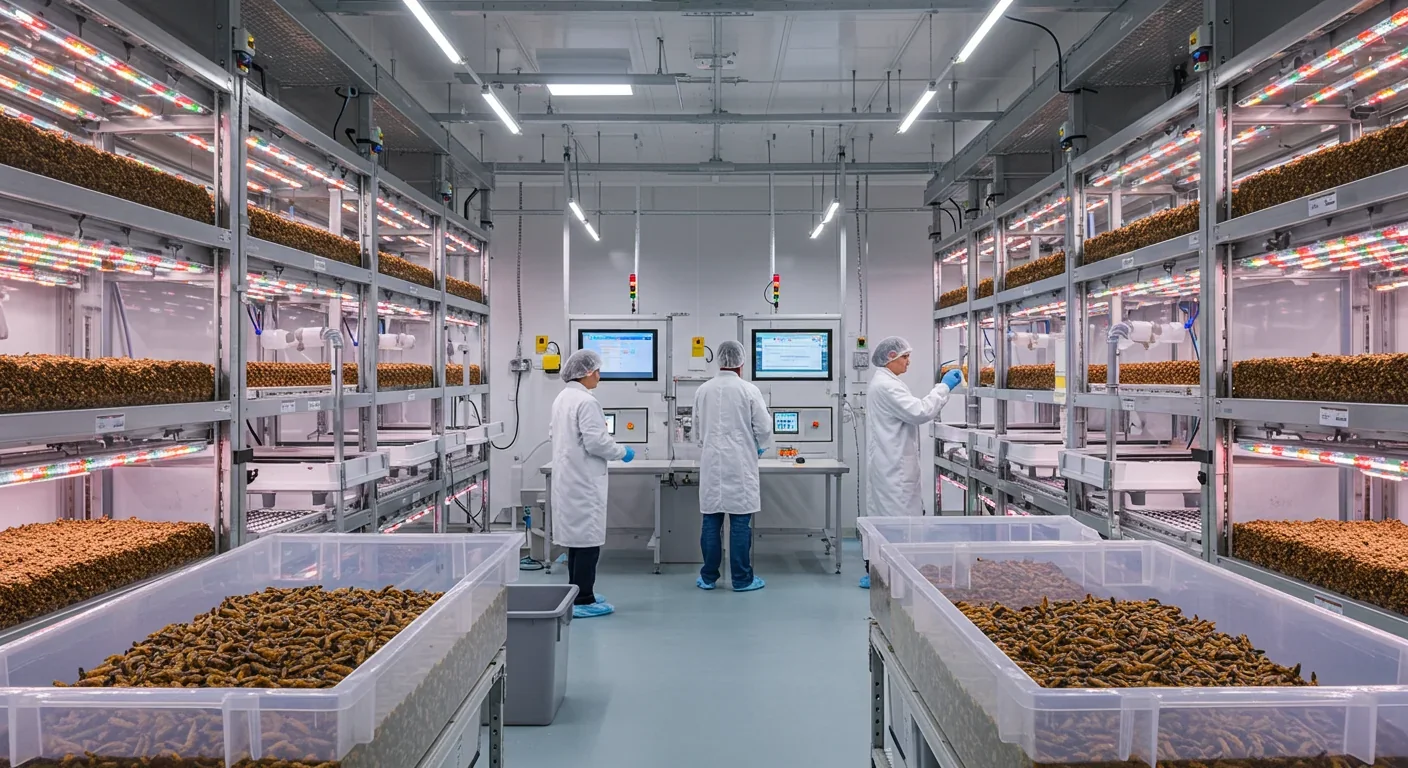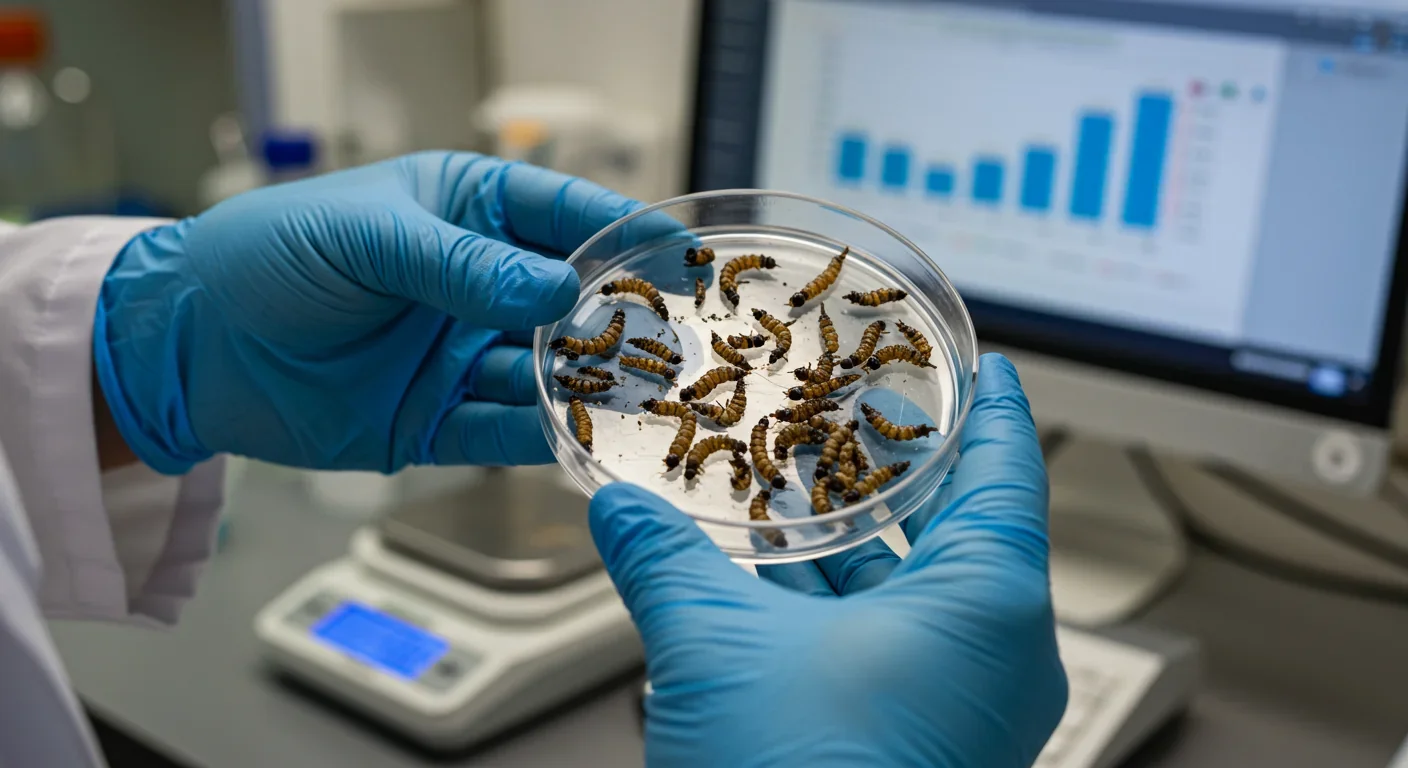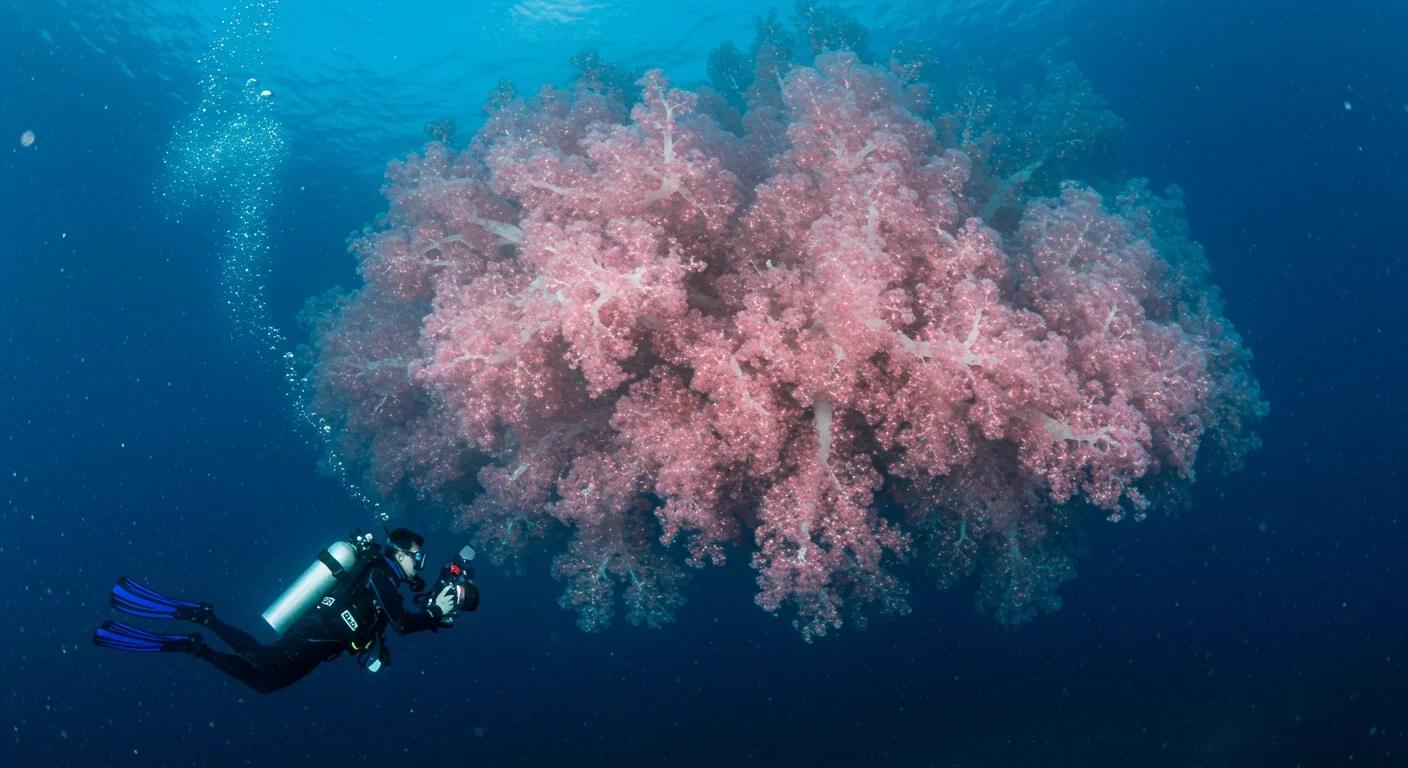Digital Pollution Tax: Can It Save Data Centers?

TL;DR: Insect protein farms are emerging as a revolutionary alternative to livestock, converting organic waste into high-quality protein with 90% lower greenhouse gas emissions, 93% less water use, and 99.6% less land than beef production. Companies like Agroloop are already operating commercial-scale facilities producing 250 tonnes of protein meal monthly from 120 tonnes of daily food waste. While consumer acceptance remains a challenge in Western markets—68% of Americans are unwilling to try insect foods—the industry is overcoming barriers through product innovation (cricket flour in pasta and bread), pet food applications, and regulatory progress in the EU and Asia. With the global insect protein market projected to grow from $1.89 billion in 2025 to $14.13 billion by 2032, the transformation of our protein supply is accelerating faster than most realize.

By 2030, you might be eating a protein bar made from crickets without even knowing it. But here's what makes this shift extraordinary: A single half-hectare insect farm can produce more protein than 1,200 hectares of cattle ranching—enough land to feed a small city. While livestock farming occupies 77% of global agricultural land yet provides only 18% of the world's calories, insect protein farms are quietly preparing to flip this equation on its head. The question isn't whether this transformation will happen—it's how fast you'll adapt to it.
Inside a 13,000-square-meter facility in Hungary, 1.8 billion black soldier fly larvae are transforming 120 tonnes of food waste every single day into 250 tonnes of protein meal, 50 tonnes of feed oil, and 900 tonnes of organic fertilizer each month. This isn't a science experiment—it's Agroloop's commercial operation, generating over €10 million annually while solving three global crises simultaneously: protein scarcity, waste management, and soil degradation.
The science behind this revolution is elegantly simple yet profoundly powerful. Insects perform bioconversion—the biological transformation of low-value organic waste into high-grade protein. Black soldier fly larvae achieve feed conversion ratios (FCR) between 1.4 and 2.6, meaning they require only 1.4 to 2.6 kilograms of feed to produce one kilogram of body weight. Compare this to cattle, which need 4.5 to 7.5 kilograms of feed for the same gain, or even chickens at 1.6. House crickets push efficiency even further, with FCRs as low as 0.9 to 1.1.
But the real game-changer isn't just efficiency—it's what insects can eat. Traditional livestock require high-quality grains and grasses. Insects thrive on organic waste streams that would otherwise rot in landfills: vegetable scraps, brewery waste, fish processing byproducts, even manure. A 2025 study found that mixed organic waste substrates achieved a 98.7% hatchability rate and 98.2% survival rate for black soldier fly larvae, with the shortest hatching time of just 3.1 days. These larvae reached a specific growth rate of 28% and maintained an FCR of 1.1—performance metrics that would make any livestock farmer weep with envy.
The Industrial Revolution transformed textile production in the 18th century. The Green Revolution mechanized crop farming in the 20th century. Now, the Protein Revolution is automating waste conversion in the 21st century—and it's happening faster than either predecessor.
Nasekomo, a European insect farming technology company, recently reported achieving approximately 25 grams of black soldier fly eggs per cubic meter per day across its reproduction enclosures—a 33% improvement over traditional crate-based systems. Their automated vertical rearing platform, combined with their MultiFly genetics program, delivers consistency, quality, and scalability that unlocks predictable egg supply for partners building bioconversion plants worldwide.
This automation revolution extends far beyond breeding. Modern insect farms employ:
Robotic feeding systems that precisely deliver substrate blends optimized for protein yield; Automated harvesting mechanisms using airflow and negative pressure to guide mature larvae into collection containers, eliminating manual labor; Real-time environmental controls maintaining optimal temperature (28-32°C) and humidity (65-75%) through AI-driven monitoring; Automated processing lines that separate protein meal, oil, and frass fertilizer from the same biomass stream.
Companies like Better Origin and Goterra have taken this further, developing plug-and-play shipping container-sized farms that can be deployed directly at waste generation sites—restaurants, grocery stores, food processing plants—turning waste into feed within hours rather than shipping it across continents.
History teaches us that agricultural revolutions follow a predictable pattern: initial resistance, gradual adoption by pioneers, sudden mainstream acceptance, and eventual dominance. The printing press took 50 years to transform Europe. Mechanized farming took 30 years to reshape American agriculture. Insect protein farming is moving faster—the industry has attracted $1.65 billion in investment over the past decade, and the global insect protein market is projected to explode from $1.89 billion in 2025 to $14.13 billion by 2032, a compound annual growth rate of 33.3%.
Understanding insect bioconversion requires grasping three biological advantages that mammals simply cannot match:
Poikilothermic metabolism: Insects are cold-blooded, meaning they don't waste energy maintaining constant body temperature. A cow burns roughly 40% of its feed energy just staying warm. Insects redirect that energy straight into growth and reproduction.
Complete edibility: Humans consume about 40% of a cow's body weight (excluding bones, organs, hide). With insects, nearly 80% of the biomass is digestible protein, fat, and nutrients. Nothing goes to waste.
Exponential reproduction: A single black soldier fly female lays 500-900 eggs. Crickets lay 1,200-1,500 eggs in 3-4 weeks. Mealworms complete their lifecycle and reproduce in just weeks. This reproductive velocity means insect farms can scale production in months rather than the years required for cattle herds.
The production process varies by species but follows a universal template:
Stage 1: Breeding – Adult insects are housed in controlled environments optimized for mating and egg-laying. For black soldier flies, this means 25-30°C and specific light conditions. Nasekomo's MultiFly program has refined breeding protocols to deliver elite genetic lines with superior FCRs and growth rates.
Stage 2: Hatching & Rearing – Eggs hatch within 24-96 hours depending on species. Larvae are transferred to rearing beds containing precisely formulated substrate blends. Research from a 2025 Frontiers study demonstrated that mixed organic waste—combining fruit/vegetable waste, brewery spent grains, fish processing waste, and poultry manure—produced larvae with the highest protein content (53.5% from fish waste substrates) and optimal fat composition (35.6% from brewery waste).
Stage 3: Growth – This is where the magic happens. Black soldier fly larvae mature in just 12 days under ideal conditions. During this period, they consume their body weight multiple times daily, converting waste into biomass at rates that defy conventional agriculture. Crickets mature in 3-4 weeks, mealworms in 8-12 weeks.
Stage 4: Harvesting – Automated systems trigger self-harvesting behavior. Black soldier fly larvae naturally migrate to dry areas when ready to pupate. Modern farms use this instinct, creating ramps and channels that guide larvae into collection bins. Airflow systems and negative pressure further automate the process.
Stage 5: Processing – Harvested larvae are frozen or blanched, then dried using various methods (oven-drying, freeze-drying, or microwave-assisted extraction). The dried biomass is milled into protein meal or further processed to extract oil and chitin. The remaining residue becomes frass—the nutrient-rich byproduct that functions as an exceptional organic fertilizer.

The ripple effects of insect protein farming extend far beyond agriculture, touching every corner of modern civilization.
Food Systems Resilience: Supply chain disruptions from the COVID-19 pandemic, the Suez Canal blockage, and the war in Ukraine exposed the fragility of global protein supply chains. Insect farms can operate locally, near waste sources and consumption centers, dramatically shortening supply chains. Urban vertical insect farms are already producing protein in Singapore, Amsterdam, and San Francisco—cities where traditional livestock farming is impossible.
Occupational Shifts: The insect farming industry is creating entirely new job categories—insect geneticists, bioconversion engineers, substrate optimization specialists, and frass agronomists. Simultaneously, it's reducing demand for traditional roles in industrial livestock farming. Agricultural workers accustomed to cattle or pig operations are retraining for insect farm management, a transition that requires new skills but offers cleaner working conditions and higher-margin products.
Geopolitical Protein Independence: Europe currently imports massive quantities of soy from South America for livestock feed, creating dependency and driving deforestation. The WWF estimates that British insect farms alone could replace 20% (500,000 tonnes) of imported soy by 2050 with proper investment and policy support. This shift would fundamentally alter agricultural trade patterns and reduce Europe's vulnerability to disruptions in South American supply chains.
Cultural Identity Evolution: Food is deeply intertwined with cultural identity. The shift toward insect protein challenges fundamental assumptions about what constitutes acceptable food. Yet history shows cultures adapt. Sushi was considered exotic and off-putting in the United States until the 1980s; today, it's mainstream. Lobster was once considered trash food, served to prisoners; now it's a luxury. Insect protein is undergoing a similar transformation, accelerated by clever product design that hides whole insects inside familiar formats—cricket flour in pasta, mealworm powder in protein bars, black soldier fly meal in pet food.
The environmental case for insect protein isn't just strong—it's overwhelming.
Water Conservation: Producing one kilogram of beef protein requires approximately 15,400 liters of water. The same amount of insect protein requires roughly 1,000 liters—a 93% reduction. With water scarcity affecting 2 billion people globally, this efficiency gain alone justifies the transition. Mealworm production uses 500% less water than beef and 50% less than poultry.
Land Liberation: Less than 0.5 hectares of black soldier fly larvae can produce more protein than 1,200 hectares of cattle grazing or 52 hectares of soybeans. If even 10% of global beef consumption shifted to insect protein, we could reclaim an area larger than the entirety of India for reforestation, rewilding, or carbon sequestration projects.
Climate Impact: Life cycle assessments confirm that insect protein production generates 10 to 100 times fewer greenhouse gas emissions than equivalent beef protein. Beef production releases approximately 27 pounds of CO2-equivalent per pound of steak. Cricket farms emit under 3 pounds per pound of protein—a 90% reduction. Unlike cattle, which produce methane (a greenhouse gas 28 times more potent than CO2), most farmed insect species produce no methane whatsoever.
Circular Economy Creation: Insect farms transform the liability of organic waste into the asset of protein and fertilizer. Agroloop's facility diverts 120 tonnes of food waste daily from landfills—waste that would otherwise decompose and release methane. Black soldier fly larvae bioconversion produces 47 times lower CO2-equivalent emissions than traditional composting. Meanwhile, the frass byproduct—rich in nitrogen, phosphorus, and potassium—replaces synthetic fertilizers. Field trials in Uganda showed that maize treated with black soldier fly frass achieved 30% higher yields than conventional fertilizer treatments.
Nutritional Density: Insects aren't just protein—they're nutritional powerhouses. Cricket flour delivers 60% protein by weight (surpassing chicken breast at 31% and eggs at 13%), plus nine essential amino acids, calcium, iron, potassium, vitamin B12, B2, and fatty acids including omega-3s. Black soldier fly larvae contain higher levels of zinc and iron than lean meat, with calcium content comparable to milk. This nutritional profile makes insect protein particularly valuable for addressing malnutrition in developing nations and protein deficiency in aging populations.
Economic Margins: While initial capital costs remain high, operational margins are compelling. Protix, operating a 14,000-tonne-per-year facility in the Netherlands, has raised €227 million in debt and equity, demonstrating investor confidence. Aspire Food Group secured $16.8 million from the Canadian government alone to build the world's largest cricket protein manufacturing facility, with a cost structure of 25% government grant, 30% loan, and 45% equity—de-risking that would be impossible for conventional livestock operations.
Yet the path to mainstream adoption is littered with obstacles—some technical, others psychological, and many economic.
The Disgust Factor: Consumer acceptance remains the single largest barrier in Western markets. A 2022 survey found that 68% of Americans are unwilling to try insect-based foods, compared to 91% willing to try plant-based alternative meats. This "yuck factor" is deeply rooted in cultural conditioning. As Dr. Sarah Dales notes, "The rise of farming led to insects being seen more as pests and vectors of disease, which further entrenched the mindset that they have few benefits."
However, research using Extended Protection Motivation Theory reveals a more nuanced picture. A 2024 study of Italian consumers found that response efficacy (belief that insect protein helps the environment) and self-efficacy (confidence in one's ability to purchase and prepare insect foods) both positively predict purchase intention, with path coefficients of 0.260 and 0.286 respectively. Disgust does negatively impact intention (coefficient of -0.217), but it can be overcome through education emphasizing environmental benefits and product familiarity.
The food industry has discovered that hiding insects works. Cricket flour can replace up to 20% of wheat flour in pasta without statistically significant differences in consumer acceptability. Trials with bread found that 15% cricket flour substitution increased protein content by 80% without loss of volume or chewiness. Fermented insect-based bread improves flavor acceptance and nutrient bioavailability. Pet food has led the way—dog owners are willing to pay an additional $2.70 for an 18-pound bag of insect protein-based dog food compared to plant-based options, and pets enthusiastically accept the taste.
Scaling Economics: Despite efficiency advantages, insect protein currently costs more than conventional alternatives. Cricket flour averages around $40 per pound ($88/kg), compared to commodity whey protein at roughly $20 per pound. These premiums reflect limited commercialization, few processing facilities, and the capital intensity of automated production systems.
European pioneers have struggled with this economic reality. Ÿnsect, despite raising massive capital, faces financial difficulties with 2023 revenue of only €5.8 million against third-party liabilities of approximately €104 million. Agronutris filed a safeguard procedure with a commercial court, giving the company six months to restructure and secure new investors. As Maye Walraven of InnovaFeed observes, "Only the most robust models will survive." InnovaFeed itself has pivoted to a modular development model to secure industrial and technological ramp-up—a strategy that appears more sustainable than the mega-facility approach that trapped competitors.
Paul Brown-Kenyon, CEO of Nutrition Technologies, explains how cost barriers can be overcome: "By leveraging the tropical climate found in Malaysia, we're able to deliver results with a much lower CAPEX spend. Fermenting low-nutrient organic waste creates a nutrient-rich feedstock for insects that can cut raw material costs by up to 5 times compared to using byproducts from wheat and corn." Geographic arbitrage, substrate optimization, and integrated technology are gradually driving costs toward parity.
Regulatory Fragmentation: While the EU has led regulatory approval—authorizing seven insect species for human consumption and multiple species for animal feed through successive amendments to Regulation 999/2001—other regions lag. The US FDA has approved certain species for animal feed, but human consumption approvals remain piecemeal, often treated as Generally Recognized As Safe (GRAS) ingredients without comprehensive regulatory frameworks. Singapore approved 16 species for human consumption in 2024, while most of Asia, Africa, and South America lack clear approval pathways.
This fragmentation stifles investment. As one industry report notes, "There is a considerable void in comprehensive legal frameworks to maintain the quality and safety of arthropod-sourced food items." Companies face the catch-22 of regulatory uncertainty deterring the large-scale production needed to prove safety, while regulators hesitate to approve products without proven large-scale safety data.
Feedstock Contamination: Insects bioaccumulate contaminants from their feed. Heavy metals, pesticide residues, and antibiotic traces in organic waste can concentrate in larval biomass, creating food safety risks. Professor Louw Hoffman warns, "While the fly can clean up toxic waste including heavy metals, flies bred for human food must be fed a clean source of organic waste." Establishing certified clean waste streams and implementing testing protocols adds cost and complexity.
Worker Health Risks: Occupational exposure to insect proteins and chitin dust can trigger respiratory sensitization and allergic reactions in farm workers. As production scales, ensuring adequate ventilation, protective equipment, and exposure limits will be critical—additional costs that further squeeze margins.
Antinutritional Factors: Some insect species contain compounds that reduce nutrient absorption. Thiaminase in certain species degrades vitamin B1. Phytates and oxalates can bind minerals, reducing bioavailability. These factors must be understood and mitigated through processing (heat treatment, fermentation) or selective breeding—adding another layer of technical complexity.

The insect protein revolution looks radically different depending on where you stand on the globe.
Asia-Pacific: This region leads both consumption and production. Insect eating (entomophagy) has been culturally embedded for millennia across Thailand, Vietnam, China, and dozens of other nations. China's edible insect industry alone was expanding at 25% annually, reaching $2.3 billion by 2020. Government support is robust—Thailand's government actively promotes cricket farming to support rural incomes, while Singapore's aggressive approval of 16 species signals intent to become a regional insect protein hub.
Scientific innovation is accelerating. Japanese researchers achieved a 1.8-fold increase in amino acid retention in black soldier fly larvae by suppressing the HiNATt gene—a breakthrough that could double protein yield per kilogram of larvae. This genetic engineering frontier positions Asian research institutions at the cutting edge of insect optimization.
Europe: The regulatory vanguard. The European Food Safety Authority (EFSA) has issued 10 positive safety opinions on insects as novel food ingredients as of 2025, following systematic risk assessments. The European Commission has authorized commercialization through successive implementing regulations, creating the world's most mature legal framework for insect food products.
Yet European companies face a challenging contradiction: advanced regulations but high production costs. Labor and energy costs in Western Europe make it difficult to compete with Asian producers on price. The high-automation, mega-facility strategy pursued by Ÿnsect and Agronutris struggled with capital intensity, while InnovaFeed's modular, co-located approach (partnering with ADM crush plants to access cheap feedstock) appears more viable. Europe may ultimately specialize in genetics, equipment manufacturing, and premium-segment products rather than commodity insect protein.
North America: Venture capital optimism meets consumer skepticism. Between 2015 and 2020, North American insect farming enterprises received over $300 million in venture capital. In 2020, the Canadian government invested $16.8 million in Aspire Food Group to develop what was marketed as the world's largest cricket protein manufacturing factory—a public-private partnership signaling government belief in the sector's strategic importance.
Yet consumer acceptance lags. The 68% of Americans unwilling to try insect-based foods reflects deep cultural aversion. The industry has responded by focusing on pet food (a $121 billion market in 2023, with pets far less finicky than their owners) and livestock feed, delaying the consumer food battle until product formats and pricing improve.
Africa: The silent revolution. Traditional insect consumption remains common across sub-Saharan Africa, providing essential nutrition in regions with limited access to conventional animal protein. Small-scale insect farming for both consumption and feed is growing rapidly with support from FAO and local governments. The potential is enormous—insect farms can operate in regions where water scarcity makes cattle ranching impossible and where high population growth is straining protein supply.
International cooperation is nascent but critical. The International Platform of Insects for Food and Feed (IPIFF) works to harmonize regulations and share best practices. The FAO actively promotes insect farming for food security and environmental sustainability. Yet competition for intellectual property and market share is intensifying. Will insect genetics be open-source or proprietary? Will production concentrate in low-cost regions or distribute locally? Will wealthy nations import insect protein or build domestic capacity? These questions will shape the geopolitics of protein for decades.
Whether you're an entrepreneur, investor, policymaker, or simply a conscious consumer, the insect protein revolution demands engagement.
For Entrepreneurs: Opportunities span the entire value chain. Breeding specialists can develop superior genetic lines (like Nasekomo's MultiFly). Equipment manufacturers can supply automated rearing systems, harvesting mechanisms, and processing equipment to farms globally. Substrate specialists can optimize waste stream blends and fermentation protocols to maximize FCR and protein yield. Product developers can create consumer food formats that overcome disgust through familiarity—insect flour pizzas, protein bars, pasta, baked goods. Logistics innovators can build modular, container-based farms for on-site waste processing. The modular farm opportunity is particularly compelling—companies like Goterra and Better Origin are selling turnkey systems that can be deployed in weeks rather than years.
For Investors: Due diligence must scrutinize business models carefully. The mega-facility, vertically integrated approach has repeatedly stumbled on capital intensity and execution risk. More promising are specialized, modular strategies: companies focusing on specific value chain segments (breeding, processing, product formulation) and partnering for the rest. Co-location strategies that site farms adjacent to cheap feedstock sources (like InnovaFeed at ADM plants) and secure long-term offtake agreements with major feed companies. Geographic arbitrage plays that leverage low-cost labor and favorable climates in Southeast Asia, Africa, or South America while serving premium markets in Europe and North America.
Protix's €227 million in funding and 14,000-tonne capacity demonstrate that patient capital and disciplined scaling can succeed. InnovaFeed reports that 75-80% of its volume is locked into long-term offtake contracts with Cargill, ADM, and others—a revenue model that de-risks the supply side.
For Policymakers: Regulatory clarity is the single most valuable contribution governments can provide. The EU's approach—systematic safety evaluations by EFSA followed by species-specific authorizations—creates predictability that unlocks investment. Contrast this with regulatory voids in much of the developing world, where insect farming remains legally ambiguous.
Beyond regulation, subsidies and grants can accelerate deployment. Nasekomo received a €2.5 million grant under the EU Seal of Excellence and Bulgaria's National Recovery and Resilience Plan. Aspire's $16.8 million Canadian government investment shifted a risky venture into a viable commercial operation. Public procurement policies that prioritize low-carbon protein in school lunches, military rations, and government cafeterias can create guaranteed demand.
Crucially, policy must address feedstock regulations. As The Bug Factory notes, "Currently, insects are treated as livestock, and so cannot be fed food waste." This regulation, designed to prevent disease transmission in conventional livestock, artificially raises insect feed costs and undermines the circular economy logic. Updating biosecurity rules to permit controlled feeding of food waste to insects—with appropriate safety testing—would dramatically improve economics.
For Consumers: Start small. If whole insects feel too extreme, try cricket flour in a familiar product—pasta, protein bars, bread. Feed insect-based products to pets, who care nothing about taboo and everything about taste. When purchasing decisions present options, choose the lower-impact protein source. Advocate for insect protein options in workplace cafeterias, schools, and restaurants.
Most importantly, question the cultural conditioning that treats insect consumption as disgusting while accepting far more objectively questionable industrial livestock practices. As Professor Louw Hoffman puts it, "If you care about the environment, then you should consider and be willing to eat insect protein."
Skills to Develop: The insect protein economy will demand new competencies. Entomology and insect biology provide foundational understanding. Bioprocess engineering skills translate directly to optimizing rearing conditions and yields. Waste management and substrate science expertise becomes valuable for formulating optimal feed blends. Food science and product development knowledge enables creation of consumer-acceptable formats. Regulatory affairs and food safety capabilities help navigate the complex approval landscape. Even marketing and consumer psychology skills are crucial for overcoming disgust and building brand acceptance.
Educational institutions are responding. Universities across Europe, North America, and Asia are launching programs in insect farming, entomology applications, and alternative proteins. Online courses and industry certifications are proliferating. The workforce is building.
We stand at an inflection point. Global population is projected to reach 9.7 billion by 2050. Protein demand will soar, yet the environmental limits of conventional livestock farming are painfully clear—livestock occupies 77% of agricultural land, consumes vast quantities of water, and contributes 14.5% of global greenhouse gas emissions. Climate change is making traditional rangelands less productive just as demand surges. Something has to give.
Insect protein farms offer a scientifically proven, economically viable, environmentally superior alternative. The technology works. The biology is sound. The economics are improving. Regulatory frameworks are emerging. Investment is flowing.
What remains uncertain is speed of adoption. Will consumer acceptance accelerate as younger generations prioritize environmental impact over cultural taboo? Will regulatory harmonization unlock global trade in insect protein? Will geopolitical shocks—droughts, pandemics, conflicts—force rapid dietary shifts? Or will entrenched livestock interests and psychological barriers slow the transition to a crawl?
The answer likely lies in the middle. Insect protein won't replace beef overnight. But within the next decade, you'll find cricket flour in your grocery store's baking aisle, mealworm protein bars in the snack section, and black soldier fly meal in your pet's food bag—as normal as quinoa or almond milk, once exotic foods that became mainstream.
Agroloop's Rajmond Percze captures the entrepreneurial optimism driving this revolution: "I could have established an IT or media company or whatever, but I have two kids and my wife, and when they recall me in the future, they should know that 'he tried everything he believed in to make the earth a better place.'"
The choice is yours: cling to the familiar and watch the world change around you, or lean into the transformation and help shape the protein system of the future. Either way, the insects are coming—1.8 billion larvae at a time, turning your yesterday's waste into tomorrow's protein, one meal at a time.

Over 80% of nearby white dwarfs show chemical fingerprints of destroyed planets in their atmospheres—cosmic crime scenes where astronomers perform planetary autopsies using spectroscopy. JWST recently discovered 12 debris disks with unprecedented diversity, from glassy silica dust to hidden planetary graveyards invisible to previous surveys. These stellar remnants offer the only direct measurement of exoplanet interiors, revealing Earth-like rocky worlds, Mercury-like metal-rich cores, and ev...

Hidden mold in homes releases invisible mycotoxins—toxic chemicals that persist long after mold removal, triggering chronic fatigue, brain fog, immune dysfunction, and neurological damage. Up to 50% of buildings harbor mold, yet most mycotoxin exposure goes undetected. Cutting-edge airborne testing, professional remediation, and medical detox protocols can reveal and reverse this silent epidemic, empowering individuals to reclaim their health.

Data centers consumed 415 terawatt-hours of electricity in 2024 and will nearly double that by 2030, driven by AI's insatiable energy appetite. Despite tech giants' renewable pledges, actual emissions are up to 662% higher than reported due to accounting loopholes. A digital pollution tax—similar to Europe's carbon border tariff—could finally force the industry to invest in efficiency technologies like liquid cooling, waste heat recovery, and time-matched renewable power, transforming volunta...

Transactive memory is the invisible system that makes couples, teams, and families smarter together than apart. Psychologist Daniel Wegner discovered in 1985 that our brains delegate knowledge to trusted partners, creating shared memory networks that reduce cognitive load by up to 40%. But these systems are fragile—breaking down when members leave, technology overwhelms, or communication fails. As AI and remote work reshape collaboration, understanding how to intentionally build and maintain ...

Mass coral spawning synchronization is one of nature's most precisely timed events, but climate change threatens to disrupt it. Scientists are responding with selective breeding, controlled laboratory spawning, and automated monitoring to preserve reef ecosystems.

Your smartphone isn't just a tool—it's part of your mind. The extended mind thesis argues that cognition extends beyond your skull into devices, AI assistants, and wearables that store, process, and predict your thoughts. While 79% of Americans now depend on digital devices for memory, this isn't amnesia—it's cognitive evolution. The challenge is designing tools that enhance thinking without hijacking attention or eroding autonomy. From brain-computer interfaces to AI tutors, the future of co...

Transformers revolutionized AI by replacing sequential processing with parallel attention mechanisms. This breakthrough enabled models like GPT and BERT to understand context more deeply while training faster, fundamentally reshaping every domain from language to vision to multimodal AI.